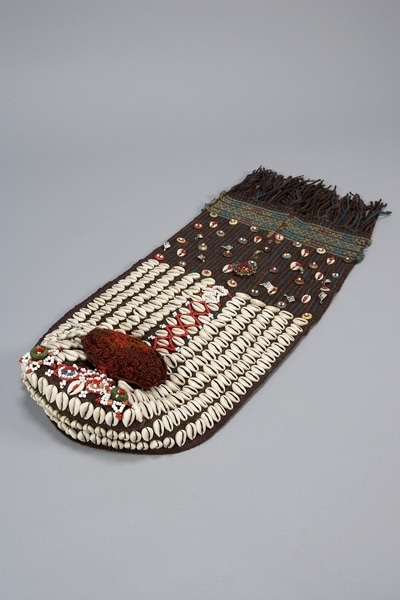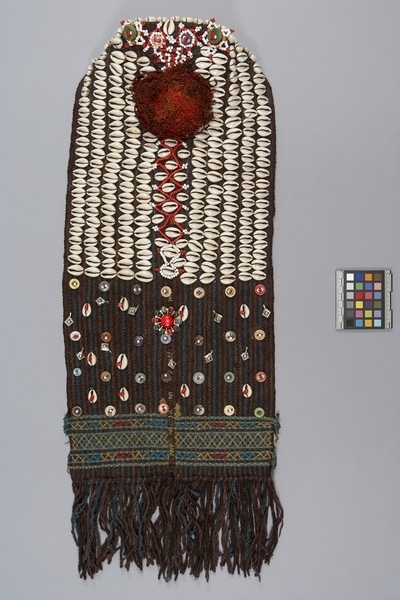Headdress Item Number: 1498/2 from the MOA: University of British Columbia


Description
A woman’s headdress consisting of a crown and a broad panel that hangs down along the back. It is shaped from a piece of coarsely woven dark brown and blue textile and is heavily decorated with cowrie shells, red and white glass beads, and embroidery. The crown portion is embellished with closely-spaced rows of cowrie shells and a central strip of geometric shapes formed from red and white glass beads. There is a large brown and orange pom pom at the centre back. The “tail” is decorated with scattered small buttons of various kinds and small silver diamond-shaped ornaments. A costume jewelry brooch (gold with red and blue stones) is pinned in the centre. There is a strip of embroidered geometric shapes at the end of the “tail", and the bottom edge is finished with a braided fringe formed from the warp threads of the textile.
History Of Use
Worn by girls and women on top of the shusut (see 1498/1) on ceremonial occasions.
Iconographic Meaning
Cowries symbolize female sexual parts and therefore invoke fecundity.
Narrative
The Kalash are geographically isolated in several valleys in northern Pakistan, close to the Afghan border. Although they are surrounded by Islamic peoples, their religion is polytheistic, with a Vedic pantheon. Linguistically, however, they are related to Afghani and the languages of Swat.
The dark brown wool textile may have been dyed with walnuts. The shells, bark and nuts themselves are used to obtain a dark colour.
Item History
- Made in Chitral, Northwest Frontier, Pakistan
- Owned by Marta Friesen before January 13, 1992
- Received from Marta Friesen (Donor) on January 13, 1992
What
- Name
- Headdress
- Identification Number
- 1498/2
- Type of Item
- headdress
- Material
- wool fibre, goat hair fibre ?, cotton fibre, cowrie shell, glass, plastic and dye
- Manufacturing Technique
- woven, braided, embroidered, appliqued and sewn
- Overall
- height 79.0 cm, width 29.4 cm, depth 8.0 cm
Who
- Culture
- Kalash
- Previous Owner
- Marta Friesen
- Received from
- Marta Friesen (Donor)
Where
- Holding Institution
- MOA: University of British Columbia
- Made in
- Chitral, Northwest Frontier, Pakistan
When
- Ownership Date
- before January 13, 1992
- Acquisition Date
- on January 13, 1992
Other
- Item Classes
- textiles
- Condition
- good
- Accession Number
- 1498/0002